Thailand just may have one of the best cuisines in the world. But with so many flavours on offer, what is actually Thailand ‘s national dish?
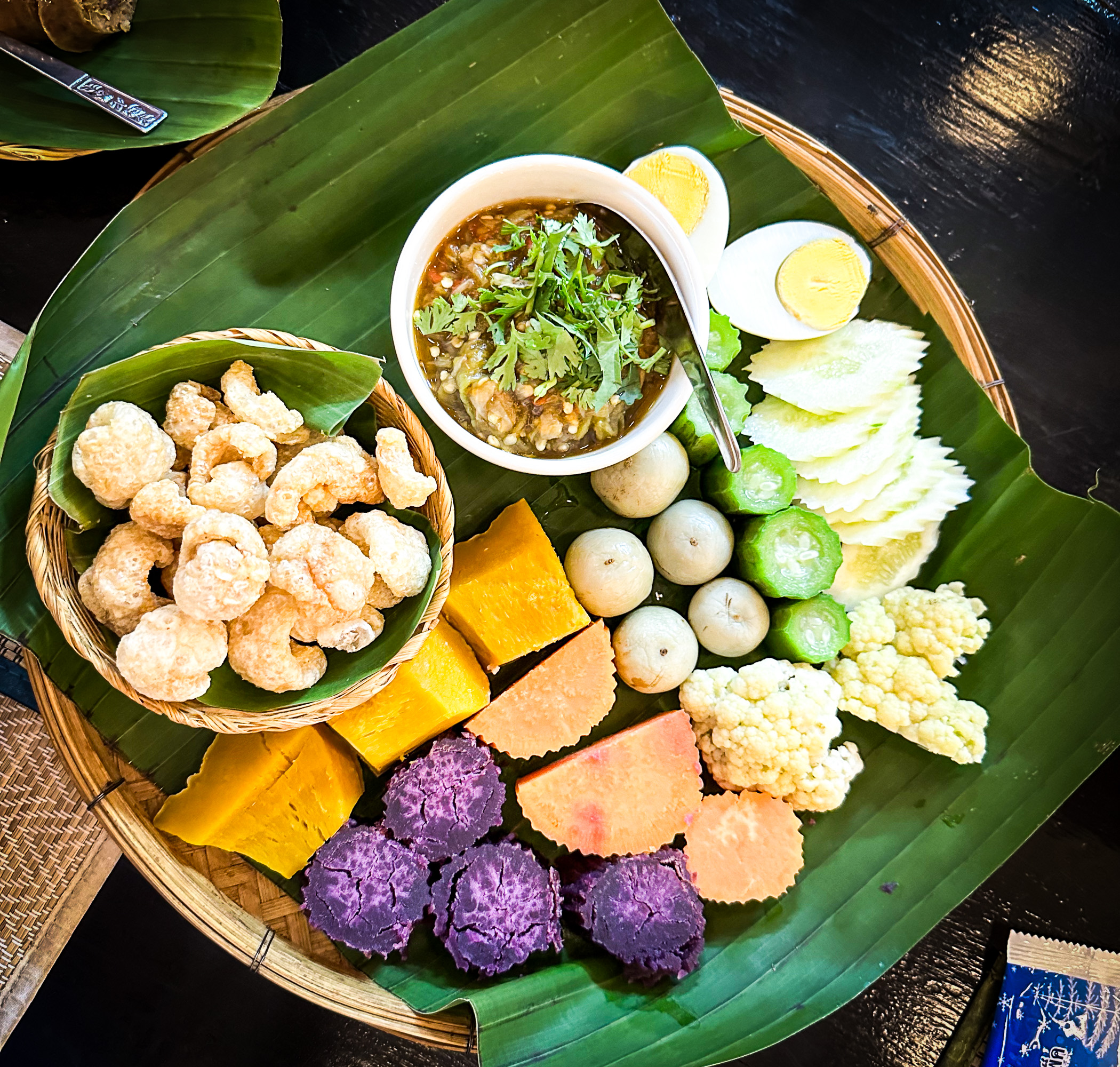
What is Thailand’s National Dish?
Anyone who’s ever come across Thailand’s culinary scene has come across one star dish: the unmistakeable Pad Thai!
This mouthwatering stir-fried noodle dish is often hailed as the national dish of Thailand, and for good reason. With its perfect blend of sweet, sour, salty, and umami flavors, Pad Thai has earned its place in the hearts (and stomachs) of locals and food enthusiasts worldwide.
Is it technically a national dish? Not that I could find out. I’ve visited the country many times, not to mention sought out Thai dishes across the world, and haven’t been able to find an official decree on the matter.
Close runners up would be Tom Yum, Green Curry and Som Tum, more about them later.
But for now, let’s push aside the notion of paperwork and committees and focus on the dish at hand. The wonderful world of Pad Thai.
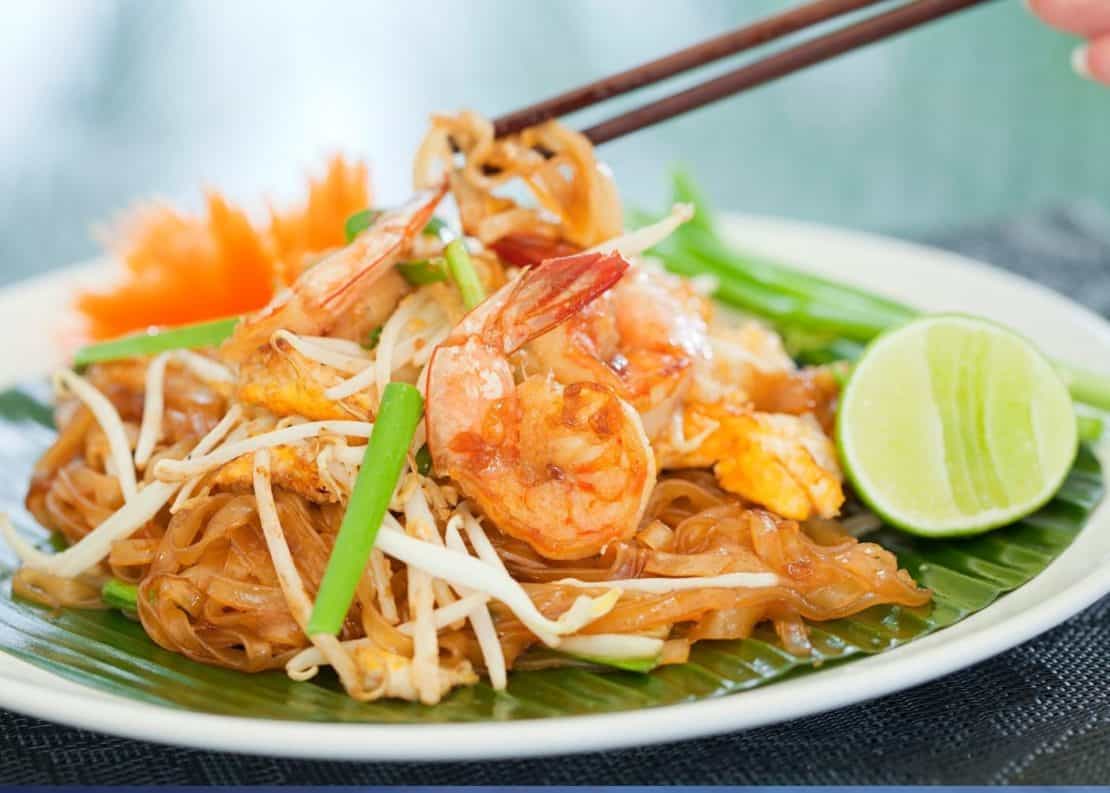
What is Pad Thai?
This stir-fried noodle dish combines thin rice noodles with a mix of tofu, shrimp, bean sprouts, and scrambled egg, all glazed in a balanced sweet and tangy tamarind sauce.
Topped with crushed peanuts and a squeeze of lime, Pad Thai is easy to appreciate, with a balance of different flavours.
The History of Pad Thai
While the exact origins of Pad Thai remain buried in the mists of time, this beloved dish has a fascinating history.
It built its popularity during the 1940s and 1950s when Prime Minister Plaek Phibunsongkhram deliberately set out to promote Thai nationalism and unity.
To achieve this, he encouraged the consumption of rice noodles, a symbol of Thai identity, and even held a nationwide cooking contest that contributed to the dish’s popularity.
Pad Thai, as we know it today, is believed to have evolved from an existing noodle dish called “kuai tiao Pad” or “Pad mee Korat.” The original version features wide rice noodles stir-fried with various ingredients such as shrimp, tofu, peanuts, and dried shrimp.
Notably, the scarcity of rice during World War II played a significant role in the popularization of Pad Thai. Facing economic challenges and limited access to rice, the Thai government promoted Pad Thai as a cost-effective and nutritious dish. The recipe was simplified and standardized, making it more accessible to people across the country.
In the decades that followed, Pad Thai evolved and adapted to different regional tastes and preferences. While the core ingredients remain consistent, regional variations have emerged, adding their unique twists to the dish.
Today, Pad Thai is one of the best known dishes both within Thailand and internationally.

Where to find the best Pad Thai
If you’re itching to sample an authentic Pad Thai, you won’t have to search for long in Thailand.
Whether you’re exploring the bustling streets of Bangkok or strolling through the quaint alleys of Chiang Mai or the less well known regions of Nan and Phrae, Pad Thai can be found in virtually every nook and cranny of the country.
Street food vendors, local eateries, and high-end restaurants all proudly serve up their own renditions of this Thai treasure.
As do Thai restaurants in the UK, and a growing number of traditional UK pubs.
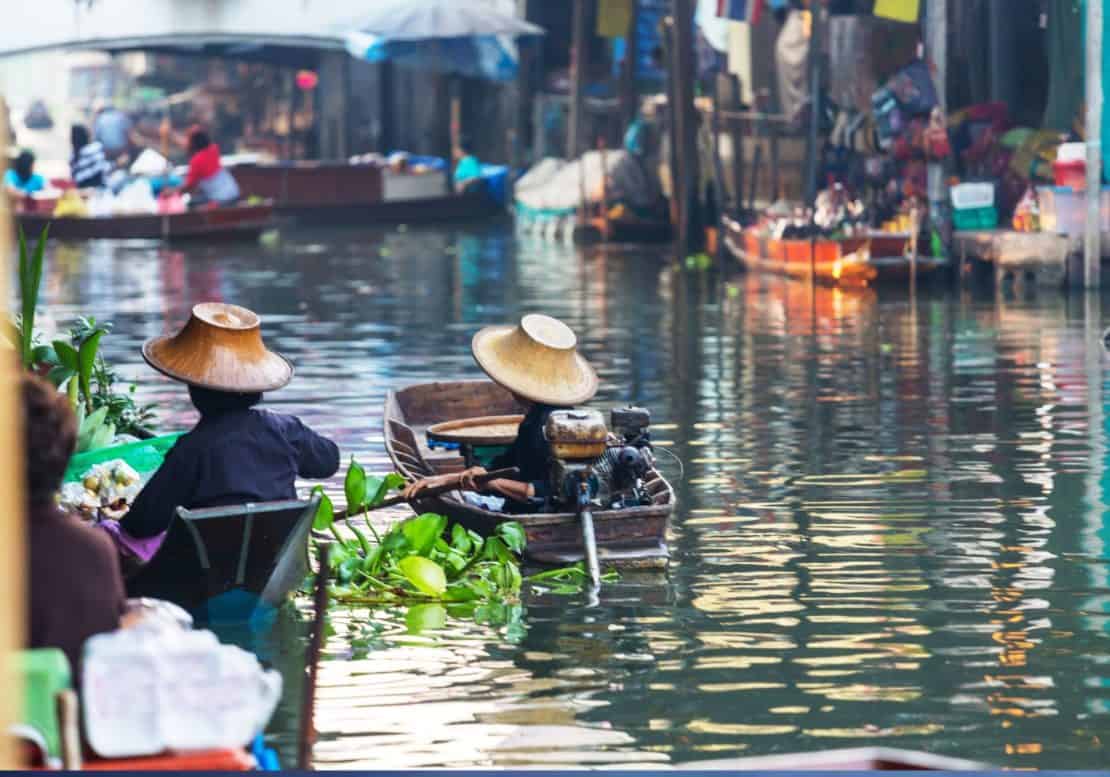
The best Pad Thai in Bangkok
For a taste of authentic street food, head to Thip Samai on Maha Chai Road, known for serving up some of the best Pad Thai in town since 1966.
If you prefer a more upscale setting, try Baan Phadthai in the Old Town, where traditional flavours meet modern presentations.
Somtum Der, with multiple locations in Bangkok, offers a perfect blend of northeastern Thai cuisine, including their Pad Thai, which can be enjoyed at a reasonable price.
Finally, for a luxurious dining experience, Thara Thong at the Royal Orchid Sheraton Hotel & Towers is an elegant choice, known for serving Pad Thai in a stunning riverside setting.
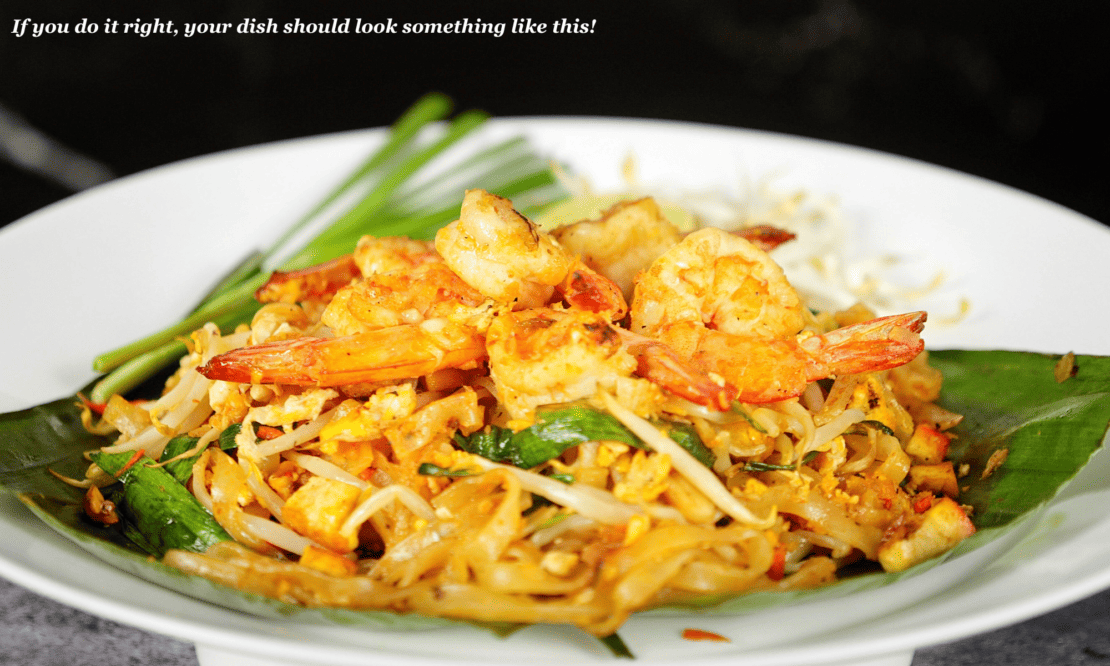
A Classic Pad Thai Recipe:
Feeling adventurous in the kitchen? Why not try your hand at whipping up some Pad Thai at home? The recipe is surprisingly simple and can be customised to suit your taste preferences.
Here’s a classic recipe to get you started:
Ingredients for Pad Thai:
- 8 ounces of dried rice noodles
- 2 tablespoons of vegetable oil
- 1/2 cup of firm tofu, cubed
- 1/2 cup of peeled and deveined shrimp (optional for non-vegetarians)
- 2 cloves of garlic, minced
- 1 egg, lightly beaten
- 2 tablespoons of tamarind paste
- 2 tablespoons of fish sauce (or soy sauce for vegetarians)
- 1 tablespoon of palm sugar (or brown sugar)
- 1 cup of bean sprouts
- 2 green onions, sliced
- 1/4 cup of crushed peanuts
- Lime wedges and cilantro for garnish
Instructions for Pad Thai:
- Soak the rice noodles in warm water for about 20 minutes until they are pliable but not fully cooked. Drain and set them aside.
- In a wok or a large skillet, heat the vegetable oil over medium heat. Add the tofu and shrimp (if using), and cook until the shrimp turns pink and the tofu is lightly browned. Push them to one side of the wok.
- Add minced garlic to the other side of the wok and sauté briefly until fragrant.
- Push the tofu, shrimp, and garlic to one side of the wok and pour the beaten egg into the empty space. Scramble the egg until it’s cooked through.
- Add the soaked rice noodles to the wok, along with tamarind paste, fish sauce (or soy sauce), and palm sugar. Gently toss all the ingredients together until the noodles are well-coated with the sauce and everything is evenly mixed.
- Add bean sprouts and sliced green onions, and continue cooking for another minute or two until the bean sprouts are slightly wilted.
- Remove the wok from the heat and sprinkle crushed peanuts over the top.
- Serve the Pad Thai hot with lime wedges and coriander (cilantro in the US) for garnish. Squeeze lime juice over the noodles just before eating for an extra zing of flavor!
Enjoy your homemade Pad Thai, and don’t be afraid to experiment with additional toppings like dried shrimp, preserved radish, or even a dash of chili flakes for some added spice.
- Why not also try your hand at cooking some Malaysian dishes with our Borneo food guide?
Other contenders for Thailand’s National Dish
Tom Yum Goong
Tom Yum Goong is a zesty and aromatic Thai soup that packs a punch. This hot and sour broth is typically infused with lemongrass, kaffir lime leaves, galangal, and chilies, creating a striking combination of tangy and spicy notes.
Prawns (Goong) are the star of this dish, but it can also be enjoyed with chicken, seafood, or mushrooms for a vegetarian twist.
Green Curry (Kaeng Khiao Wan)
Indulge in the creamy and vibrant Green Curry, known in Thai as Kaeng Khiao Wan. This popular curry is a blend of coconut milk, green chilies, Thai basil, and a medley of aromatic herbs and spices. Tender chicken, beef, or tofu swim in the rich green goodness, making it a treat that pairs perfectly with steamed jasmine rice.
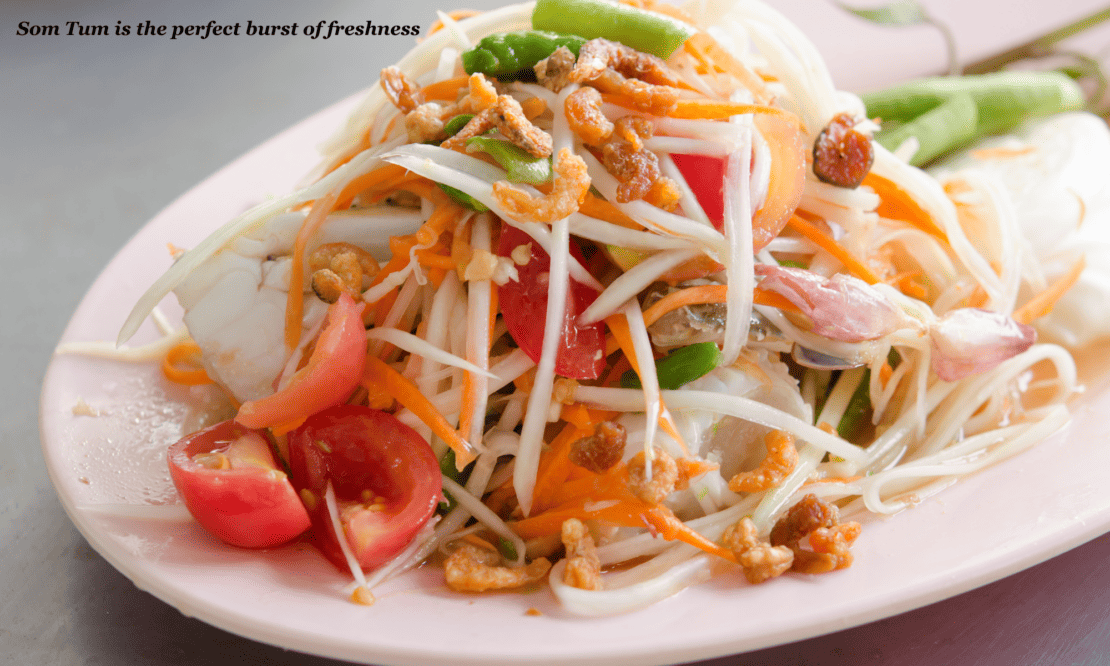
Som Tum (Green Papaya Salad)
For a burst of freshness, Som Tum comes to the rescue! This refreshing green papaya salad is a blend of shredded unripe papaya, cherry tomatoes, green beans, peanuts, and chilies, all dressed in a tangy and savoury dressing featuring lime juice, fish sauce, and palm sugar.
The mix of sweet, sour, and spicy notes creates an addictive taste that leaves you wanting more.
Massaman Curry
Hailing from Southern Thailand, this mild yet flavourful curry showcases influences from Indian and Malay cuisines. The tender meat (usually beef or chicken) is simmered in a velvety sauce enriched with coconut milk, tamarind, cinnamon, cardamom, and roasted peanuts, resulting in a comforting and aromatic dish.
Pad Kra Pao (Basil Stir-Fry)
A popular street food favorite, Pad Kra Pao, offers a quick and satisfying fix for spice enthusiasts. Sautéed with fresh Thai basil, garlic, and fiery chili peppers, this stir-fry can feature your choice of minced meat, be it chicken, pork, beef, or even seafood. Served over rice with a fried egg on top, it’s a simple yet intensely flavourful meal.
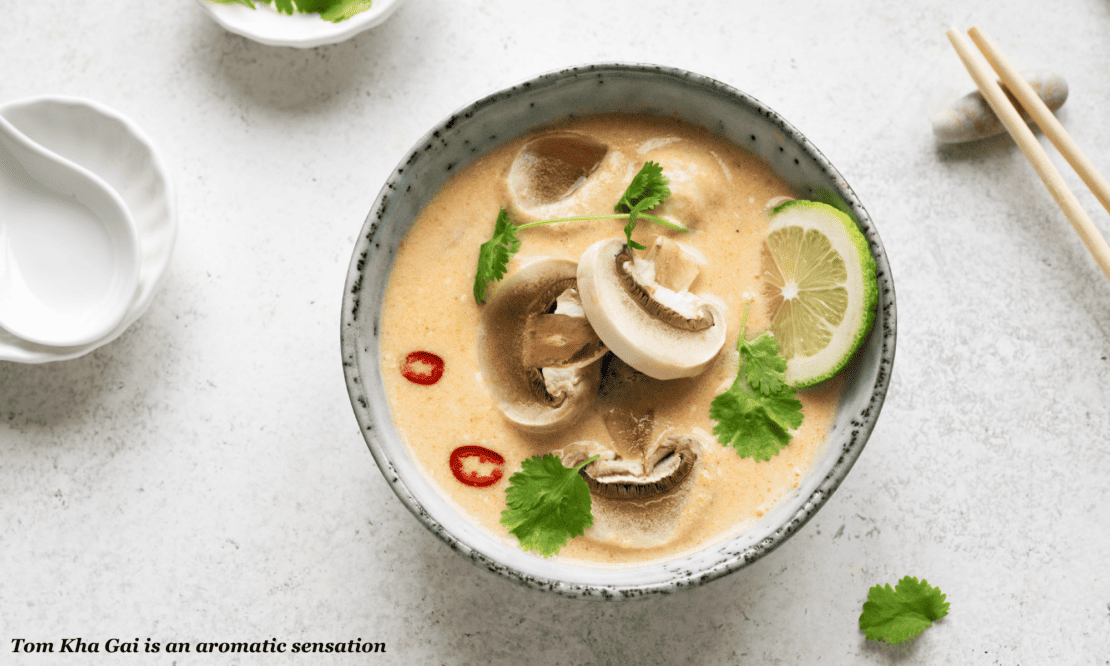
Tom Kha Gai
Tom Kha Gai is a velvety coconut milk soup that exemplifies the Thai love for balancing flavours. Infused with galangal, lemongrass, and kaffir lime leaves, this soup is enriched with succulent chicken and mushrooms, creating a delightful interplay of creamy, citrusy, and herbal notes that will warm your soul.
Pad See Ew
For noodle enthusiasts, Pad See Ew is a must-try. This comforting stir-fried dish features broad rice noodles cooked with tender slices of meat (often beef or chicken), Chinese broccoli, and a savoury blend of soy sauce and oyster sauce. The result is a delightful combination of soft noodles and crunchy greens bathed in umami goodness.
Khao Pad (Thai Fried Rice)
Simple, yet incredibly flavourful, this fried rice is stir-fried with a choice of protein (chicken, shrimp, or tofu), egg, onions, and a touch of soy sauce for that signature golden hue. Served with cucumber slices and a wedge of lime, it’s a comforting staple for Thai food lovers.
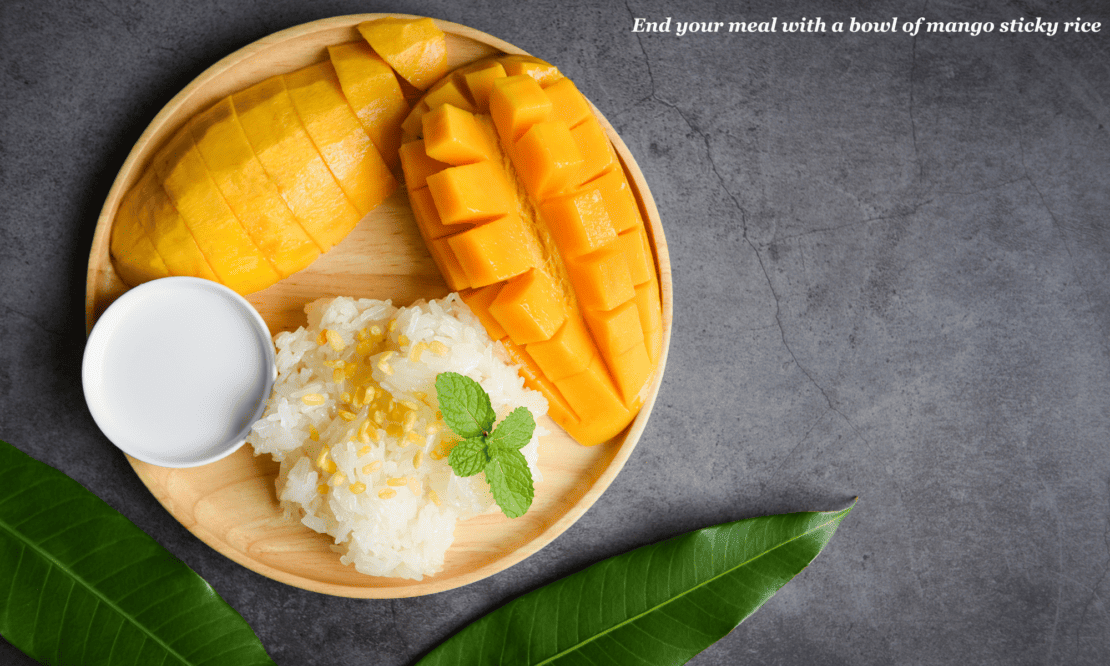
Mango Sticky Rice (Khao Niew Mamuang)
End your Thai feast on a sweet note with the delightful Mango Sticky Rice. This luscious dessert features ripe mango slices served over a bed of glutinous rice, drizzled with rich coconut milk and sprinkled with toasted sesame seeds. It may sound over the top but the creamy, tropical flavours of mango and coconut will leave you with a taste of paradise.
Where to next?
A trip to Thailand would be incomplete without a visit to Phrae (see the best things to do in Phrae here) and some time in the country’s overlooked northern provinces – here’s what not to miss in Nan. Plus, discover the best souvenirs in Thailand and make sure it’s a trip you’ll never forget.
And, of course, a Thai adventure goes well with a trip to Vietnam, too.
